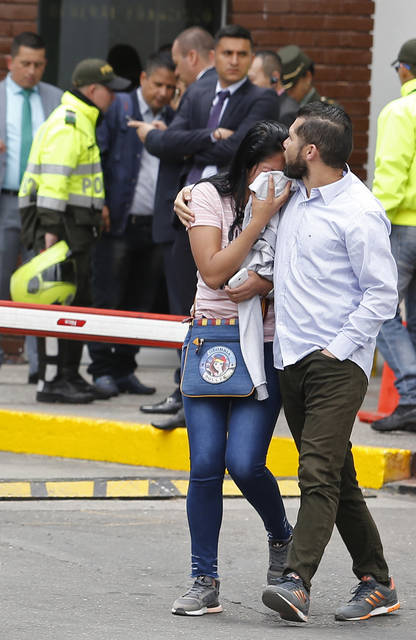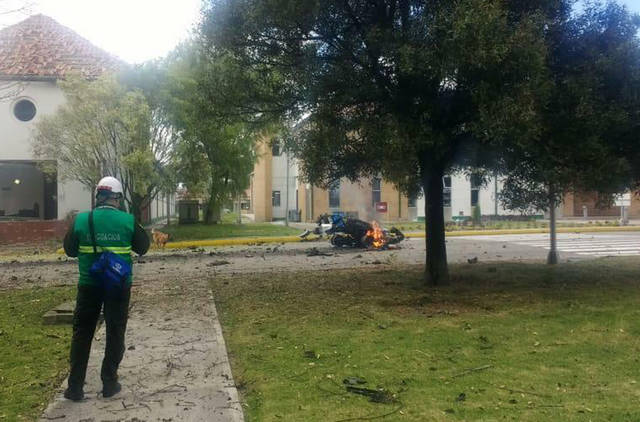BOGOTA, Colombia — Colombian authorities said that a one-armed explosives expert belonging to the country’s last remaining rebel group carried out a car bombing against a police academy that left 21 dead and dozens more wounded.
Chief Prosecutor Nestor Martinez said at a press conference Friday that the man who carried out Thursday’s brazen attack, the deadliest in 15 years in the South American nation, was a longtime member of the National Liberation Army, or ELN.
Even though Jose Aldemar Rojas had no criminal record, Martinez said that the 56-year-old man is the same individual known in intelligence reports by alias Mocho Kiko, who lost his arm manipulating explosives during a long clandestine career with an ELN cell near the border with Venezuela.
The shock bombing recalled some of the bloodiest chapters of Colombia’s recent past and has raised tough questions about lingering security threats in the wake of a 2016 peace deal with FARC rebels. It would also appear to torpedo any chance of stalled peace talks with the ELN resuming any time soon.
“The entire Colombian state,” Martinez said, “is prepared to confront with the constitution and laws in our hands those who want to ambush our national security and impose the force of terrorism.”
President Ivan Duque will announce later Friday the government’s stance on the future of the peace talks.
But Martinez said top ELN commanders, who had been living in Cuba during the peace process and are believed to have only minimal control over their troops, would be held accountable for the attack.
Overnight, the death toll from the bombing more than doubled to 21, the worst tragedy since a 2003 car bombing carried out by FARC rebels against an elite Bogota social club that killed 36. It proved especially unsettling because the target, the General Santander school, is one of the city’s most protected installations.
With the help of security cameras and fingerprints on his one-remaining left hand, investigators were able to quickly identify Rojas and determine that he was the owner and driver of a 1993 Nissan-pick up that was loaded with 80 kilograms (175 pounds) of pentolite and rammed past a security checkpoint into the leafy campus.
Defense Minister Guillermo Botero said Rojas entered the heavily guarded facility via a side entrance used for deliveries, driving fast through a gate opened to allow the exit of a few motorcycles. He then drove into the heart of the school where the vehicle exploded in front of a red tile-roofed barrack used by female cadets just after an honor ceremony had concluded.
Martinez said that less than 10 minutes before the blast an unidentified man descended from the vehicle at a nearby bus stop — an indication the bomb may have been activated remotely and not a suicide bombing as some initially had speculated.
Investigators are now trying to determine whether that man is Ricardo Carvajal, who acknowledged taking part in the attack in phone calls intercepted by police. Carvajal was arrested in a pre-dawn raid in Bogota on Friday in which authorities also seized a rebel combatant manual.
“This was an operation being planned for more than 10 months,” Botero said.
Duque, visiting the academy in the aftermath of the blast, vowed to spare no effort in fighting the “miserable” terrorists who carried out the attack.
“The terrorists are looking to intimidate us as a society,” he said in a televised address Thursday night in which he declared three days of mourning. “Colombia will demonstrate that it is a strong state, united and won’t break in the face of the dementia of these aggressions.”
Police director Oscar Atehortua said just four of the deceased cadets have been fully identified because the bodies of many of the victims were badly mutilated. He asked family members to provide DNA sample to a team of forensic anthropologists trying to identify the dead from among a list of unaccounted-for cadets.
The dead identified thus far include Erika Chico, a top-of-class cadet from Ecuador who had identification on her at the time of the attack. Of the more than 70 wounded, including three students from Panama, 10 remain hospitalized.
Videos shot on cellphones after the bombing show panicked officers hauling injured colleagues on stretchers with debris and body parts strewn in front of the skeletal steel remains of the still-burning truck.
Little is known about Rojas.
Records show he bought the car 10 months ago from Mauricio Mosquera, who Martinez said was charged in the past for terrorism and rebellion. The car was last inspected six months ago in the eastern city of Arauca, near the border with Venezuela.
The same volatile area is a stronghold of the ELN, the country’s last remaining rebel group following a 2016 accord between the government and the Revolutionary Armed Forces of Colombia that saw some 7,000 rebels disarm.
Authorities said Rojas, as a member of the hardliner Doming Lain front, traveled on several occasions to Venezuela to train rebels in the use of explosives.
The ELN has been stepping up its attacks on police targets and oil infrastructure amid a standoff with the conservative Duque government over stalled peace talks. A year ago, the group claimed responsibility for the bombing of a police station in the coastal city of Barranquilla that left five officers dead.
But until now the Cuban-inspired group, which is believed to have around 1,500 fighters, has never been capable or much interested in carrying out such a high profile act of violence.
Duque has demanded the ELN cease all attacks and kidnappings as a condition for restarting the talks and has condemned Venezuela and Cuba for allegedly providing a safe haven for rebel leaders even as their troops continue to sow violence in Colombia.
For decades, residents of Bogota lived in fear of being caught in a bombing by leftist rebels or Pablo Escobar’s Medellin drug cartel.
But as Colombia’s conflict has wound down, attacks have fallen to historically low levels and residents in turn have lowered their guard, something that magnified the shock at Thursday’s carnage.
“This is the maximum impact any terrorist act could have,” said Jorge Restrepo, director of the Conflict Analysis Resource Center.
Restrepo said he expects the attack to be a defining moment for Duque, who was elected last year on a law and order platform highly critical of his predecessor’s peacemaking but since taking office has taken a more moderate stance.
Amid the tragedy there was an outpouring of solidarity.
Dozens of residents stood in line at four collection points throughout the city to donate blood to treat the victims, 10 of whom remain hospitalized.
Lorena Mora, 25, said she spent two anguishing hours trying to find out what happened to her brother, who entered the police school seven months ago. She eventually found him at the police hospital where most of the injured officers were transported. She said he was still stunned but otherwise well, except for a sprained knee.
“When I managed to get inside and see him,” she said, “I felt instant peace.”
———
AP writers Christine Armario and Cesar Garcia contributed to this report.




